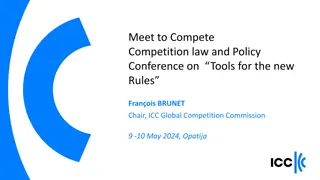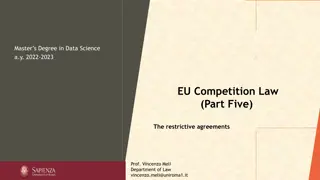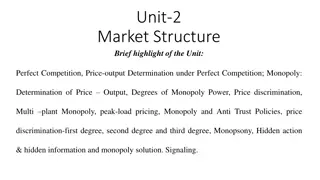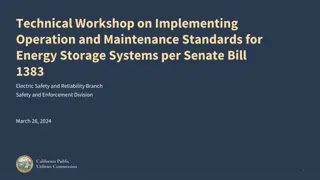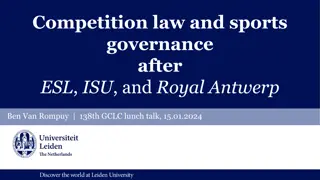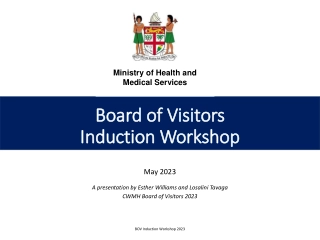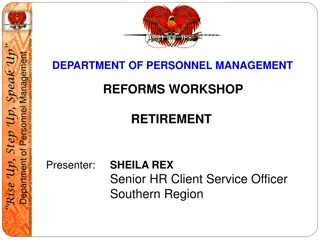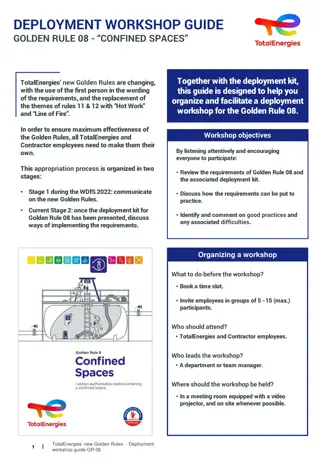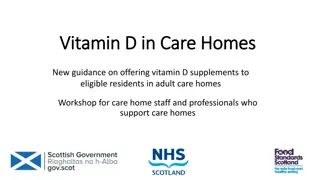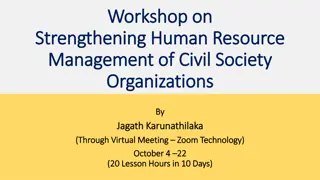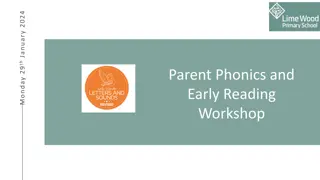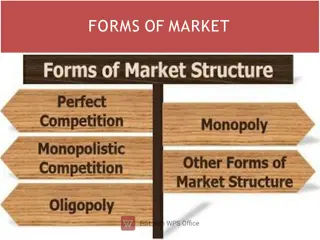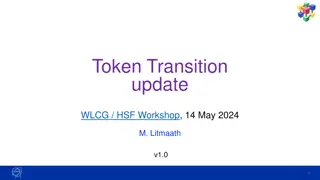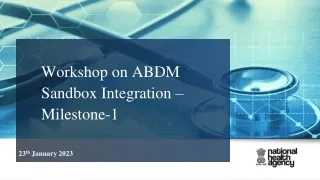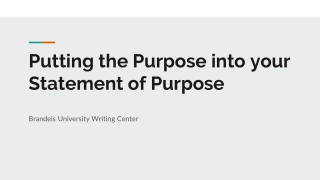PINCCER Competition Workshop FEB 2024
The article discusses the market concentration levels in smaller African economies like South Africa and Zambia, focusing on the impact on competition and consumer welfare. It highlights the Competition Amendment Act and the effectiveness of market inquiries in identifying and addressing competition issues. The appointment of Minister Ebrahim Patel has been influential in advocating for a more inclusive economy.
Download Presentation
Please find below an Image/Link to download the presentation.
The content on the website is provided AS IS for your information and personal use only. It may not be sold, licensed, or shared on other websites without obtaining consent from the author. Download presentation by click this link. If you encounter any issues during the download, it is possible that the publisher has removed the file from their server.
Presentation Transcript
PINCCER Competition Workshop FEB 2024 Bringing an economic framework to the policy table John Oxenham 1
Concentration levels across Africa Smaller African economies characterized by high degrees of market concentration when compared to large economies, including South Africa and Zambia. High degrees of concentration may result in familiar theories of harm, often prosecuted in the latter two jurisdictions. The South African Competition Commission ( SACC ) announced a list of priority sectors in 2008 on which it would focus investigations, principally on the basis of perceived concentration. These sectors included: Food and agro-processing; Construction and infrastructure; Intermediate industrial products; Healthcare; Telecommunications; Energy; and Financial Services The main considerations included: the impact on poor consumers; the importance for accelerated and shared growth; and the likelihood of substantial competition concerns based on information the Commission gathers from complaints and merger notifications. The results were negligible, despite the SACC s prioritization initiatives. An important catalyst for change was the appointment of Min Ebrahim Patel as the Minister of the Department of Trade, Industry and Competition ( DTIC ) in 2019. There is little doubt that his influence has been significant in advocating for a more transformed and inclusive economy . 2
Competition Amendment Act, 1 of 2009- objective standard First introduced South Africa s market inquiry regime. (amendments 1 April 2013). The 2009 Amendment Act enabled the SACC to initiate market inquiries on the basis of comparable international competition law standards: (i) if it has reason to believe that any feature or combination of features of a market for any goods or services prevents, distorts or restricts competition within that market; or (ii) to achieve the purposes of the Competition Act. The amendments permitted the following powers: following a market inquiry, the SACC was required to submit a report of its findings with, or without, non-binding recommendations. These recommendations may include: new or amended policy, legislation or regulations and recommendations to other regulatory authorities in respect of competition matters; recommendations to firms to change their conduct. In regard to the efficacy of the inclusion of a market inquiry regime, Bonakele, das Nair and Roberts state: the inquisitorial process has been very valuable in identifying and remedying competition issues more expeditiously than the adversarial process in enforcement investigations. This has been the case both where independent panels and the Commission s own team conducted the inquiries. Issues relating to competition policy questions such as barriers to entry and the ability of smaller firms to compete have also been canvassed in inquiries. Recommendations on these competition-plus issues have tended to require improved regulation and/or related policy measures, for which inquiries have played an important agenda-setting role 3
Table of Market Inquiries pre-2019 amendments Date Sector Issues Findings Conditions Imposed/Recommendations 2006 - 2008 Banking The level and structure of charges made by banks Relation between costs of providing retail banking services (and the charges thereof) Process used to set charges Level and scope of existing and potential competition Inter alia, it was found that the costs to customers to switch banks were enough to create a significant degree of customer captivity and to confer market power on banks. Recommended, inter alia: that the Banking Association develop a set of minimum standards for the disclosure of product and price information to be included in the Banking Association Code of Banking Practice. measures be implemented to reduce search costs and to improve the comparability of banks product offerings and prices. measures to reduce switching costs and assist customer switching. that the mandate of the ombudsman for banking services be expanded to include enforcement and monitoring of compliance with codes of conduct for information disclosure and switching. (Initiated in terms of Section 21 General Provisions) and/or payment 2013 - 2019 Private Healthcare (Initiated in terms of 2013 Amendments) Costs of private healthcare were high Costs were high due to: highly concentrated funders and hospital markets disempowered and uninformed consumers lack of value-based purchasing practitioners with no regulatory oversight lack of accountability on several fronts Recommended regulatory reforms to encourage competition: lower costs and prices value-for-money for buyers innovation in delivery and funding of the sector 2014 - 2017 Liquified Petroleum Gas (Initiated in terms of 2013 Amendments) Structural features of the market High switching costs Regulatory environment that hindered competition High degrees of concentration on both a refinery and wholesale level High regulatory barriers to entry Found that there was limited domestic supply of LPG and that gaps were filled by imports Prevalence if long-term supply agreements allowing wholesalers to making their market positions For lower costs, necessary to obtain import efficiency and optimization for sourcing Less regulatory bodies Wholesale licenses must be issued and observed by the National Energy Regulator of South Africa ( NERSA ) MOUs are to be used to align the processes of NERSA and Transnet National Port s Authority Agreements can only go up to 10 years and unlimited renewal clauses can not longer be utilized In terms of 2-year supply agreements, small wholesalers are entitled to 10& of LPG productions by refineries 4
Table of Market Inquiries pre-2019 amendments (cont.) Date Sector Issues Findings Conditions Imposed/Recommendations 2014 - 2017 Liquified Petroleum Gas (Initiated in terms of 2013 Amendments) Structural features of the market High switching costs Regulatory environment that hindered competition High degrees of concentration on both a refinery and wholesale level High regulatory barriers to entry Found that there was limited domestic supply of LPG and that gaps were filled by imports Prevalence if long-term supply agreements allowing wholesalers to making their market positions For lower costs, necessary to obtain import efficiency and optimization for sourcing Less regulatory bodies Wholesale licenses must be issued and observed by the National Energy Regulator of South Africa ( NERSA ) MOUs are to be used to align the processes of NERSA and Transnet National Port s Authority Agreements can only go up to 10 years and unlimited renewal clauses can not longer be utilized In terms of 2-year supply agreements, small wholesalers are entitled to 10& of LPG productions by refineries 2015 - 2019 Grocery Retail (Initiated in terms of 2013 Amendments) Concentration derived from: exclusive leases with malls better rebates offered from four large national chains High degrees of concentration (top 5 retailers accounted for roughly 64% of the market) High barriers to entry at the retail level Found that national supermarket chains have significant bargaining power and often entered into exclusive long-term lease agreements resulting in foreclosure effects. National supermarket chains were able to exert buyer power. Recommended: phasing out of exclusive leases with immediate termination of enforcement of leases against SMEs, speciality stores & grocery retailers in rural areas exclusivity cannot be included in future leases or lease renewals supplier rebates: large suppliers to sign up to a Code of Conduct ensuring all rebates are widely available and they have an objective justification 2017 - 2019 Data Services (mobile telecommunications)- (Initiated in terms of the 2013 Amendments) Prices of mobile data Prices were high and structurally anti-poor Mobile Providers to come to voluntary settlement agreements with the Commission 5
An Evolving Legal Standard The Competition Amendment Act, 18, 2018 brought significant changes to the market inquiry regime, (first introduced by the 2009 Amendment Act). In particular, the SACC now has a: duty to remedy adverse effects on competition andmust consider, in particular, the impact of the adverse effect on competition on small and medium businesses, or firms controlled or owned by historically disadvantaged persons . Evidently, where the SACC finds there to be an adverse effect on competition, it has a duty to remedy this adverse effect. Should the SACC find an adverse effect , the 2018 Amendment Act permits the SACC to take all reasonable and practicable action to remedy, mitigate or prevent the adverse effect . In this regard, the recommendations imposed by the SACC are binding. Where, however, the SACC recommends structural remedies on a firm, such structural remedy requires approval by the Competition Tribunal. The broadened powers and significantly lowered thresholds (legal test), as a result of the 2018 Amendment Act, permits the imposition of remedies which may not otherwise be ordered by the South African Competition Tribunal, under the conventional competition and economic test framework, and most importanyly after an adjudicated hearing. Accordingly, in relation to market inquiries, the SACC acts as judge, jury and executioner . Independence of the agency? 6
Cost of Living the SACC Concentration Report (2021) implementation of the new standard In 2021, the SACC released its Economic Concentration Report: detailed patterns of concentration in South Africa emphasised the SACC s power to launch market inquiries into identified concentrated industries and its authority to now impose structural remedies on businesses operating in these sectors. The purpose of structural remedies is said to remove barriers to entry, specifically for SMEs ad HDP firms Due to South Africa s history, the markets and ownership structures are concentrated. Competition regulation was implemented to aid in the economic transformation and reform from racialized economic structures High concentrated industries in South Africa include ICT, Energy, Financial Services, Food and Agro-processing, Infrastructure and Construction, Intermediate Industrial Products, Mining, Pharmaceuticals and Transport The revised market inquiry provisions were designed to: promote improvements and protection in competition, reduce concentration, promote broader participation and spread of ownership and as a result, constitute economic transformation. address concentration levels, promote SME development, address the racially skewed ownership spread in terms of merger control, structural remedies, navigating abuse of dominance and market inquiries While Market Inquiries are an important tool which have the potential to be effective in small economies insofar as competition and appropriate remedies can facilitate an ease on the all important cost of living, if used without restraint there are significant concomitant risks. 7
SACC Report (2021)- Changes in concentration over time Industries with increasing concentration Industries with declining concentration Relatively consistent ( 2 percentage points) Total Highly concentrated with a presumptively dominant market participant 59.5% 19.0% 21.4% 42 Highly concentrated without a presumptively dominant market participant 35.9% 35.9% 28.2% 39 Moderately concentrated 31.8% 45.5% 22.7% 22 Less concentrated 25.0% 41.7% 33.3% 12 Total 42.6% 32.2% 25.2% 115 (Source: Summary report of findings and recommendations, 2021) 8
SACC Report (2021): Changes in concentration over time Over-represented and highly concentrated industries that are experiencing increases in concentration: Farming inputs Agro-processing Sin industries (alcohol and gambling) Healthcare (medical schemes, administration and pharmacy) Communications (fibre to the home) Upstream steel value chain (iron and ferrochrome mining) Financial services (specialist insurance) The findings were as follows: Dominant firms are more prone to raising entry barriers and excluding rivals It is necessary for enforcement to focus on markets with dominant firms Where market contain oligopoly structures, enforcement is necessary to reduce concentration and encourage participation (subject to the oligopoly structure s economies of scale) Proactiveness is key to ensure that markets do not become concentrated which might mean more extensive attentiveness in merger control 9
Table of Market Inquiries post-2019 amendments- significant caveats Date Sector Issues Findings Conditions Imposed/Recommendations Lack of integration and inequality between and within transport modes Skewed subsidy system Policy frameworks are required Lack of integration and inequality between and within transport modes Skewed subsidy system Policy frameworks are required Government to consider facilitating tender contracts into smaller contracts which will create room for new entrants and SMEs To embrace an integrated system and improve coordination, transport authorities at provincial/metropolitan/district/municipal and create local capacity to ensure prioritisation of transport planning Equal allocation of subsidies to transport modes 2017 - 2021 Public Passenger Hampering of competition between the platforms Hindering competition between business users or undermining consumer choice Giving rise to abusive treatment of business users Disadvantageous impacts on the ability of SMEs and/or HDPs to participate in the market Tendency to sell top ranking search positions to businesses which impacts on consumer choice and competition (especially for SMEs) Extreme levels of fee discrimination against SMEs Conflicts in operating a marketplace for third party sellers and own retail products SACC found there to be distinct lack of participation by HDPs in online platform markets and even low representation amongst the business users on the intermediation platforms Implemented measures across various product markets to facilitate the entry of HDP and SMEs into the market. Consumer-aiding search filters Marketing incentives to purchase local goods Removal of restrictive pricing clauses Segregation of internal (competing) divisions Removal of automatically directing mechanisms to larger players Disclosure clauses to consumers and other benefits to SMEs, HDPs and consumers Ordered Takealot to separate its retail and marketplace divisions 2021 - 2023 Online Intermediation Platform Concentration and market power Regulatory barriers barrier to entry and expansion (production and supply) In terms of upstream suppliers, price setting mechanisms downstream metal fabricators Assessment of key logistics infrastructure Steel Industry that impact - - 2023 Ongoing (with specific focus on iron ore and coking oil) transport and 10
Table of Market Inquiries post-2019 amendments (cont.) - caveats Date Sector Issues Findings Conditions Imposed/Recommendations Value chain efficiency Market dynamics surrounding inputs Barriers to entry Expansion Participation Every stage of the value chain assessed and broken down: inputs, production, wholesalers and intermediaries (agents), national fresh produce markets, distribution, marketing and retailers 2023 - Ongoing Fresh Produce - - The Publishers Support Services submitted that there has been a widespread shift towards digital news consumption which has resulted in a substantial decline in advertising revenue and increase in resource costs for sustaining of newsrooms digital presence Existence of dominant gateways like Google and Meta Media dependency on these gateways for user-facing services Lack of transparency in terms of algorithms 2023 Ongoing Media and Digital Platforms - - The Draft Terms of Reference indicates focus on the following: Price and access to primary inputs Impact of large producer s access to primary inputs Extent of commercial bargaining power between contract growers and producers at all levels of the value chain Role of retailers, quick-service restaurants, processed food companies in accommodating new entrants and market access by independent producers including SMEs and HDPs 2024 - Ongoing Poultry - - 11
The Evolution of Market Inquiries in South Africa 6 in a four-year period 5 in a 12-year period 2006 2018 2024 2019 Post - Pre - amendment amendment Steel Industry Grocery Retail Data Banking Poultry Public Passenger Competition Amendment Act 2019 Liquified Petroleum Gas Health Care Fresh Produce Online Intermediation Platform Media and Digital Platforms 12
Key Takeaways Market Inquiries have the potential to be particularly valuable in small economies specific challenges can be addressed through obtaining a better understanding of the market through access to current, accessible data; competition will be promoted; consumer protection is at the core of the process; and effective remedies may be imposed Market inquiries such as the Fresh Produce Market Inquiry focused on vital inputs and products to address cost of living issues: fruits and vegetables/groceries (costs of living). Concerns regarding findings of uncompetitive and unfair pricing in the industry arose during the Covid-19 Pandemic. The SACC Concentration Report (2021) flagged trends of concentration and participation of farmers, those who have a direct nexus to cost of living issues : According to studies, there appears to be broad concern over price levels and volatility of pricing for fresh produce in South Africa. The studies show that high prices of fresh produce have disproportionate effects on the poor and low-income earners who have to spend a greater portion of their income to purchase essential products. 13
Key Takeaways Risks : Costly (industry-dependent and based on timelines) Enforcement of remedies and recommendations Liability of information provided through investigations Lack of expertise/knowledge from authorities Competition authorities should also be wary to place too onerous of a burden on firms conducting business within their particular jurisdiction. Where lower legal and economic tests are applied to achieve a particular result, this may have negative concomitant impact on local business and may also deter foreign direct investment (which is needed in small economies) The modifications brought about during the 2019 amendments were important resulting in a significant evolution in the legal standard/ test. The adverse effects test plays a major role especially in addressing the market environments for LSMs, HDPs and SMMEs. The modifications seek to address the pervasive market concentration and barriers to entry in markets by enhancing the mandate of the competition authorities subsequently granted broader powers and lower thresholds for intervention. Independence of agency of significant importance 14


